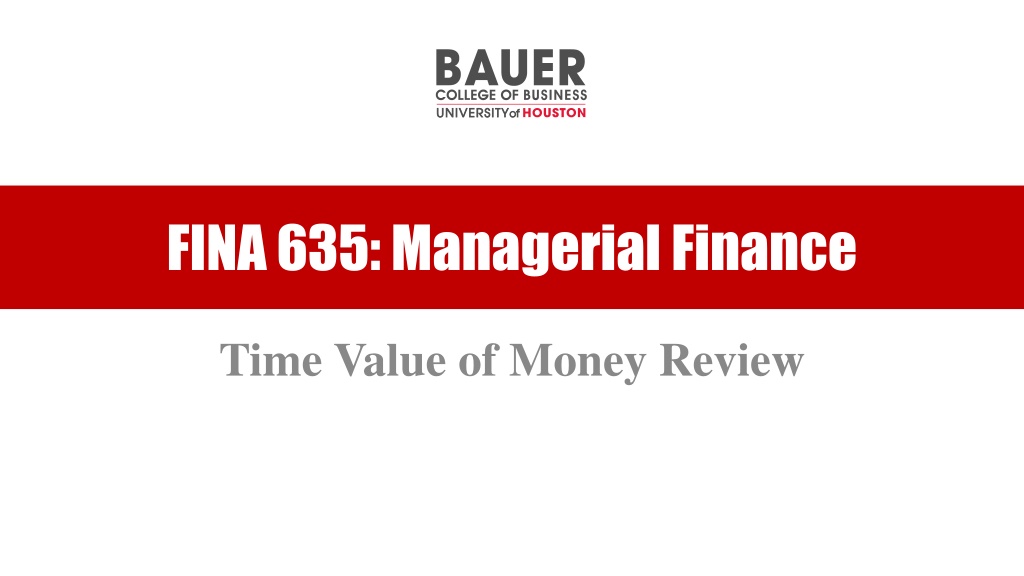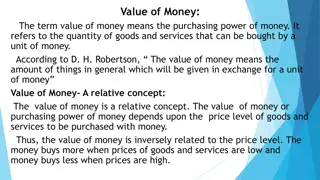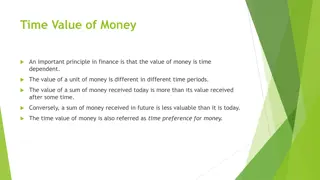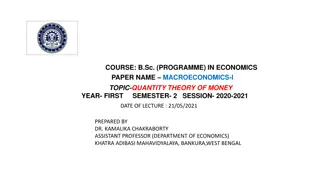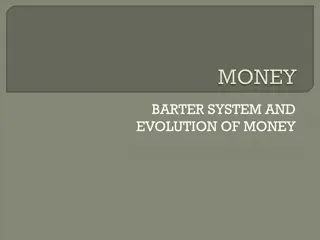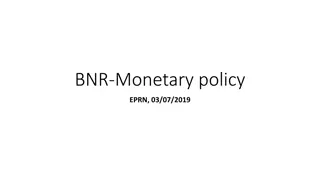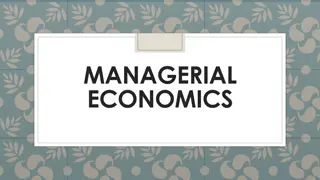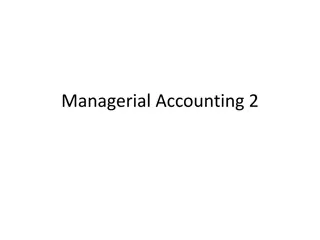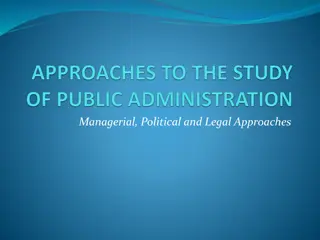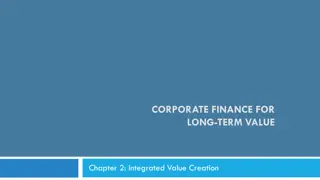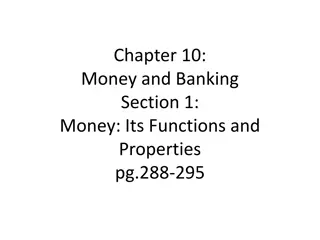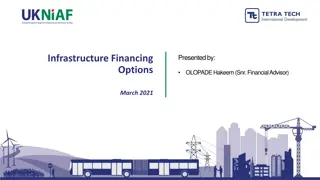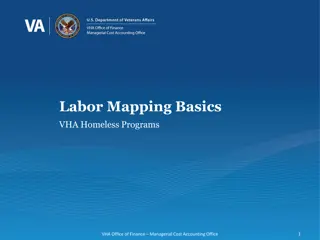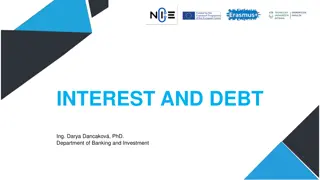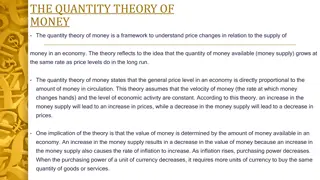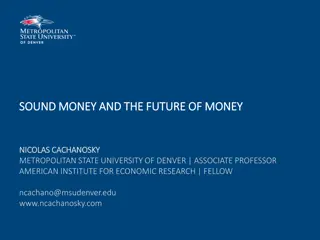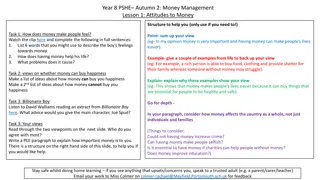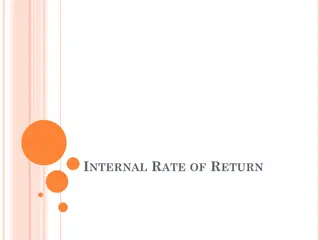Managerial Finance: Time Value of Money Review
This review delves into scenarios involving cash flows, future value, and present value calculations at different time periods and interest rates. It covers calculations for future cash flow values, present values, and investment decisions based on revenue projections and interest rates. The examples provided offer practical insights into managerial finance concepts.
Download Presentation

Please find below an Image/Link to download the presentation.
The content on the website is provided AS IS for your information and personal use only. It may not be sold, licensed, or shared on other websites without obtaining consent from the author. Download presentation by click this link. If you encounter any issues during the download, it is possible that the publisher has removed the file from their server.
E N D
Presentation Transcript
FINA 635: Managerial Finance Time Value of Money Review
QUESTION #1 Consider a cash flow of $100 received five years from now and an interest rate of 5%. t t=0 t=5 C=$100
QUESTION #1: PART (A) Consider a cash flow of $100 received five years from now and an interest rate of 5%. t=10 t=0 t=5 FV=? C=$100 Calculate the future value of this cash flow ten years from now. ???= ? ? + ?? ??10= 100 1.055= $???.??
QUESTION #1: PART (B) Consider a cash flow of $100 received five years from now and an interest rate of 5%. t=0 t=5 ??0=? C=$100 Calculate the present value of this cash flow at time zero. ? ???= ?+?? 100 1.055= $??.?? ??0=
QUESTION #1: PART (C) Consider a cash flow of $100 received five years from now and an interest rate of 5%. t=2 t=0 t=5 ??2= ??2=? ??0= $78.35 C=$100 What will be the value of this cash flow two years from now? 100 ??2= 1+0.053= $??.?? ??2= 78.35 1 + 0.052= $??.??
QUESTION #1: PART (D) Assume interest rates of 2% and 10% t=10 t=0 t=5 FV=? C=$100 Calculate the future value of this cash flow ten years from now. ???= ? ? + ?? ?? ? = ?%: ??10= 100 1.025= $???.?? ?? ? = ??%: ??10= 100 1.15= $???.??
QUESTION #1: PART (E) Assume interest rates of 2% and 10% t=0 t=5 ??0=? C=$100 Calculate the present value of this cash flow at time zero. ? ???= ?+?? 100 1.025= $??.?? ?? ? = ?%:??0= 100 1.15= $??.?? ?? ? = ??%:??0=
QUESTION #2: SWEET FOOD INC. A manager is considering expanding her firm Sweet Food Inc. and developing a new production line for ice-cream. The cost of developing the production line involves an initial investment of $2.6 million today and an additional investment at the end of the first year of $1.5 million. After thorough analysis of demand for the ice-cream, the manager was able to estimate the future revenues from ice-cream sales for the next few years. The expected revenues will be $1.3 million at the end of year 2, $1.8 million at the end of year 3 and $2.1 million at the end of year 4. No production of the ice-cream will be possible after year 4 (the equipment will become obsolete). In today s Wall Street Journal the manager found that the interest rate was equal to 10 percent. t=1 t=2 t=4 t=0 t=3 $1.5? $1.3? $2.1? $2.6? $1.8?
QUESTION #2: SWEET FOOD INC. PART (A) t=1 t=2 t=4 t=0 t=3 $1.3? $2.1? $2.6? $1.5? $1.8? (a) What is the present value of the project s costs? Given: r=10% ?1 ?? ????? = ?0+ 1+?1 ?? ????? = $2.6? +$1.5? 1.1 ?? ????? = $?.???
QUESTION #2: SWEET FOOD INC. PART (B) t=1 t=2 t=4 t=0 t=3 $1.3? $2.1? $2.6? $1.5? $1.8? (b) What is the present value of the project s revenues? Should the manager execute the project? Given: r=10% ?2 ?3 ?4 ?? ???????? = 1+?2+ 1+?3+ 1+?4 ?? ???????? =$1.3? 1.12+$1.8? 1.13+$2.1? 1.14= $?.??? ??? = ?? ???????? ?? ????? = $3.86? $3.96? = ?.?? ??? < ?. Do not execute the project.
QUESTION #3: OIL PIPELINE PART (A) You own an oil pipeline which will generate a $2 million cash return over the coming year. The pipeline s operating costs are negligible, and it is expected to last for a very long time. Unfortunately, the volume of oil shipped is declining, and cash flows are expected to decline by 4 percent per year. The discount rate is 10 percent. (a) What is the PV of the pipeline s cash flows if its cash flows are assumed to last forever? t=1 t=2 t=0 t=3 $2? 1 0.042 $2?(1 0.04) $2? This is a growing perpetuity. ? ???= ? ? $2? ??0= 0.1 ( 0.04)= $??.???
QUESTION #3: OIL PIPELINE PART (B) You own an oil pipeline which will generate a $2 million cash return over the coming year. The pipeline s operating costs are negligible, and it is expected to last for a very long time. Unfortunately, the volume of oil shipped is declining, and cash flows are expected to decline by 4 percent per year. The discount rate is 10 percent. (b) What is the PV of the cash flows if the pipeline is scrapped after 20 years? t=20 t=1 t=2 t=0 t=3 $2? 1 0.0420 $2? 1 0.042 $2?(1 0.04) $2? This is a growing annuity. ? ? ?+? ?+? ???= ? ?? 20 $2? 1 0.04 1.1 ??0= 0.1 ( 0.04)1 = $??.???
QUESTION #4: FORESIGHT Attached to this problem set is a page from Foresight from the Art Institute of Chicago (all information required to solve this problem is provided below). It describes the details of a charitable annuity agreement. Let s focus on the figures for a one-person annuitant. For example, if a donor is 50 years old when the donation is made, the donor receives an annual annuity equal to 6.5% of the donation until the donor dies. If the donor is 60 years old when the donation is made, the annuity percentage is 6.9%. In this example, a donation of $100,000 would provide income to the 50-year old donor of $6,500 per year for life. The same donation would provide income to the 60-year old donor of $6,900 per year for life. Ignore tax effects for now.
QUESTION #4: FORESIGHT PART (A) (a) At what life expectancy would the donation begin to be a gift from the Art Institute tothe donor ? Donor is 50 years old Cost of capital (r)=5% The donation will become a gift from the institute to the donor when the current value of all annual payments is equal to the price of the annuity. Assume you paid $1000 for the annuity. ?? ??????? =? ?1 1+?? 1 65 0.051 1 $1000 = 1.05?
QUESTION #4: FORESIGHT PART (A) 65 0.051 1 $1000 = 1.05? 1.05?= 1 1000 0.05 1 65 1 1.05?= 1 1000 0.05 65 1 ? log 1.05 = log 1 1000 0.05 65 1 log 1 1000 0.05 65 ? = log 1.05 ? = ??.?? ????? The donation will become a gift to the donor after his 80th year.
QUESTION #4: FORESIGHT PART (B) (b) Assume that the donor is 60 years old and has a life expectancy of 25 years. Also assume that the donor and the Art Institute both have a cost of capital equal to 10%. If the donor gives $100,000 to the Art Institute for a charitable gift annuity, what is the true value of the gift to the Art Institute? Given: n=25 years; r=10%; Coupon rate=6.9%; Donation = $100,000 ?? ??????? =? ?1 1+?? ?? ??????? =6900 0.1 1 1 1 1.125= $62,631.58 ???? ????? ?? ???? = $100,000 $62,631.58 ???? ????? ?? ???? = $??,???.??
QUESTION #5: JOHNSCAR PART (A) John plans to buy a new car five years from now. Over the next five years (starting from next month) John wishes to save a certain percentage of his monthly income in a saving account that yields an interest rate of 0.2% per month. John s current monthly salary is $5,000 and is expected to stay at this level for the next five years. (a) What percentage of his salary should John allocate to savings in order to purchase a car that will cost $15,000 five years from now? t=1 t=2 t=60 t=0 ?? 1+??= 15,000 1.00260= $13,305.40 ?? = ? ?? =? 1 ? ? ? 1 1+?? FV=$15,000 ? 1 $13305.40 = 0.0021 1.00260 ? = $???.?? ?.??% ?? ?????? ? ???? ?? ????? ???? ??.
QUESTION #5: JOHNSCAR PART (B) (b) In the meantime, John is considering taking a loan from the bank in order to purchase a $5,000 old car today. John will be able to sell this car for $3,000 in five years and will repay the loan over the next five years. The bank is willing to offer John an interest rate of 0.2% per month on this loan if repaid in equal monthly payments for the next 60 months. Assume that John will use the funds received from selling the old car to purchase the new car. What percentage of his salary in total should John put aside in the next five years in order to repay the loan for the old car and save for the new car? t=1 t=2 t=60 t=0 Car rental: Payment for old car today (PV) = $5,000 Sale of old car in year 5 (FV) = $3,000 ? ? ? PV=$5,000 FV=$3,000 3000 1.00260= ? 1 ?? = 5000 0.0021 1.00260 ? = $??.?? Total savings required = $235.55+$41.41 = $276.96
QUESTION #5: JOHNSCAR PART (C) (c) Finally, John is considering an alternative of renting for the next five years (until buying the new car). For what rent would it be more cost effective to rent a car for the next five years instead of purchasing (and selling) the old car? Any rent below the increased savings required for purchasing a old car is more cost effective. i.e. Rent less than $41.41 $276.96 $235.55 ???? = $??.?? ?? ?.??% ?? ??????
QUESTION #6: NOAHSWELL PART (A) Noah s firm is considering purchasing an operating oil well. Noah expects that his firm should be able to extract 1,500,000 barrels of oil annually from this new oil well for the next 10 years. Assume an annual cost of capital of 4%. (a) Suppose that after all expenses the firm can sell a barrel of oil for profit of $25 per barrel. If this level of profits remains the same over the next 10 years, then what is the highest price that Noah s firm should be willing to pay for this well? t=0 t=1 t=2 t=10 $37.5? $37.5? $37.5? ?????? ??? ????? = $25 1.5? = $37.5? Highest price Noah would pay is present value of future cash flows from the well. ?? =? ?1 1.0410 1+??=37.5 1 1 0.041 Highest price = $304,158,591.73
QUESTION #6: NOAHSWELL PART (B) (b) Now suppose that due to an expected upward trend in oil prices in the next ten years, analysts expect that profits per barrel of oil will remain at $25 this year but will increase at a 2% annual growth rate in the following years. How should this change your answer to part (a)? This is a growing annuity. ? ? 1+? 1+? ?? = ? ?1 t=1 t=2 t=0 t 10 $37.5? 0.04 0.021 1.02 1.04 $37.5?(1.02) $37.5? ?? = ?? = $???,???,???.??
QUESTION #6: NOAHSWELL PART (C) (c) While Noah is confident regarding this year s capacity, he is a bit skeptical regarding the ability of the well to generate a steady stream of 1.5 million barrels. Noah suggested to his firm to use a more conservative approach that assumes a negative growth rate of 5% in the well s capacity starting from next year. What is the highest price that the firm should be willing to pay for this well (assume still a 2% increase in profits as in part (b))? ????? ???? ?? ??? ????? = ????? ???? ?? ??? ????? = 3.1% 1 0.05 1 + 0.02 = 0.969 10 t=1 t=2 t=0 $37.5? 1 0.031 1.04 t 0.04 ( 0.031)1 ?? = $???,???,???.?? ?? = $37.5? $37.5?(0.969)
QUESTION #7: CHARLOTTES RETIREMENT PART (A) Charlotte is exactly 30 years old and wishes to start saving for retirement. Charlotte s financial advisor advised her to save a fixed amount of $10,000 at the end of each year starting from the end of this year until she reaches the age of 65 (at that time the last installment is made). The saving account will carry an interest of 4%. (a) How much money will Charlotte have accumulated in savings at the age of 65? t=1 t=2 t=35 t=0 ?? =? 1 ? 1 1+?? $10? $10? $10? ?? =$10,000 1 1 1.0435= $???,???.?? 0.04 ?? = ?? 1 + ??= $186,646.13 1.0435 ?? = $???,???.??
QUESTION #7: CHARLOTTES RETIREMENT PART (B) (b) Charlotte however wishes to accumulate $1 million till that time. By how much shall Charlotte increase her annual payment to achieve this goal? t=1 t=2 t=35 t=0 ?? 1+??= $1? 1.0435= $???,???.??? ?? = ? ? ? ?? =? 1 ? 1 ?? = $1? 1+?? ? 1 $253,415.471 = 0.041 1.0435 ? = $??,???.?? Annual payments have to be increased by $3,577.32
QUESTION #7: CHARLOTTES RETIREMENT PART (C) (c) Suppose that at age 50 Charlotte decides to withdraw $50,000 from her saving account to cover some unexpected expense. By how much should Charlotte increase her annual payment (starting at age 51) in order to still achieve her $1 million goal? t=0 t=1 t=2 t=35 t=20 ?? =? 1 ?1 ? ? ? 1+?? ? ?? = $1? 50,000 ? 1 $50,000 = 0.04 1 1.0415 ? = $?,???.?? Annual payments have to be increased by $4,497.06to a total of$18,074.38.
